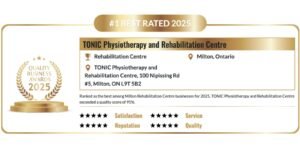There’s a moment after surgery that no one prepares you for. The hospital stay is over, the surgeon gives the all-clear, and you go home: sore, stiff, and slightly overwhelmed. That’s when the real work starts.
If you’ve undergone a mastectomy, breast reconstruction, or lymph node removal, recovery isn’t just about waiting it out; it’s about actively supporting your healing. And one of the most overlooked but vital steps? Post-surgery physiotherapy.
Because here’s the thing: without proper movement, scar tissue tightens. Muscles weaken. Fluid can build up. And the emotional weight of surgery? It doesn’t just disappear on its own. People often expect to bounce back with time alone, but real recovery isn’t passive. It’s active. And it needs support.
In this post, we’re diving into the kind of care your body deserves after major surgeries like mastectomy, lymph removal, and reconstruction. We’ll talk about what can go wrong if rehab gets skipped, what physiotherapy looks like (hint: it’s not just a few stretches), and how to regain comfort, confidence, and control over your body again.
Let’s talk recovery, honestly, practically, and with care.
Post-Mastectomy Recovery: The Role of Physiotherapy
A mastectomy is a surgical procedure to remove one or both breasts, typically as part of treatment for breast cancer or to reduce high genetic risk. Depending on the type: full, partial, or double, it can involve not just breast tissue, but sometimes muscle or lymph nodes as well.
No one tells you how different your body feels after a mastectomy, not just physically, but mentally too. The chest can feel tight, numb, or heavy. Movements you didn’t think twice about before: reaching up, rolling over in bed, or even standing tall, can suddenly feel foreign or even painful.
And while these sensations are common, they’re not something you have to “just deal with.”
Post-mastectomy physiotherapy helps restore mobility in the chest, shoulder, and upper back areas that are often affected by the surgical trauma and the body’s natural protective response. Scar tissue forms. Muscles compensate. The result? Limited range of motion, postural changes, and sometimes chronic discomfort if left untreated.
Physiotherapy doesn’t just mean doing arm lifts on a mat. It’s tailored care that includes gentle manual therapy to reduce tightness around the scar, guided exercises to gradually rebuild strength and movement, and posture correction techniques to help you stand, sit, and move more comfortably again.
It also opens the door to emotional recovery. Getting back that sense of control over your own body, even in small movements, can be a quiet but powerful win. And it matters.
Post-surgery mastectomy recovery isn’t linear. Some days feel good. Others, not so much. But with the right guidance, your body can heal better, move more easily, and start feeling like home again, on your terms.

Breast Reconstruction Recovery: How Post-Surgery Physiotherapy Helps
Breast reconstruction, whether done immediately after mastectomy or delayed until later, is a deeply personal decision, and it comes with its own unique set of challenges. The body’s healing process isn’t just about aesthetics; it’s about regaining strength, mobility, and a sense of self after major surgery.
The Physical Impact of Reconstruction
Depending on the type of reconstruction, whether implant-based or using your tissue (like a DIEP flap or TRAM flap), different muscle groups and areas of the body are affected. You can feel tightness in the chest, soreness in the abdomen, or stiffness in the shoulders and upper back.
And the more invasive the surgery, the more layers of healing your body has to work through scar tissue, muscle weakness, nerve sensitivity, and posture imbalances. It can feel like everything’s connected and yet somehow out of sync.
Where Physiotherapy Comes In
That’s where post-surgery physiotherapy steps in. It’s not just about moving the arm again; it’s about helping you reconnect with your body after everything it’s been through.
A skilled physiotherapist will work with you on:
- Scar tissue mobility – to prevent tightness and pulling, especially around the chest and abdomen
- Shoulder and chest mobility – restoring range of motion without pain or restriction
- Core re-engagement – especially important after flap procedures involving abdominal muscles
- Posture correction and breathing mechanics – small shifts that make a big difference in daily comfort
- Gradual strengthening – rebuilding confidence in movement without overloading healing tissue
Emotional Recovery Through Movement
Sometimes the hardest part isn’t physical. Your body doesn’t feel the same and that can shake your sense of identity. Physiotherapy becomes more than rehab. It’s a space to feel supported, to feel seen, and to feel progress happening in real time.
There’s no rushing the process, but there is relief in knowing you’re not doing it alone. Recovery is deeply individual, and your path should reflect that with care that adapts to your pace and respects your healing.

Lymph Node Removal After Breast Surgery: Why Physiotherapy Matters
In many breast cancer surgeries, lymph node removal is part of the process, especially if there’s a risk of spread. Often, this involves removing nodes under the arm (axillary lymph nodes), which can change how fluid drains from the upper body and how the shoulder and arm move. It’s a hidden but significant part of the recovery.
What a lot of people aren’t prepared for is how that impacts daily life. Even simple tasks like brushing your hair or reaching behind your back can feel stiff, restricted, and sometimes even painful. And yeah, nobody warns you just how odd it feels when you can’t lift your arm the same way.
Common Physical Changes After Surgery
When lymph nodes are removed, there’s often some degree of swelling, stiffness, and tightness. Some people even feel a weird mix of numbness and ache that’s hard to explain, like your arm doesn’t quite belong to you. This is especially common if there has been radiation, which can further tighten tissues around the shoulder and chest.
How Physio Makes a Difference
Physiotherapy can help restore mobility, reduce discomfort, and keep things from turning chronic. In some cases, especially when swelling lingers or fluid builds up, techniques like lymphatic drainage massage can be incredibly helpful. This gentle, specialized massage encourages fluid movement, reduces congestion, and supports tissue healing, particularly after lymph node removal.
Through gentle manual therapy, targeted movement exercises, and scar tissue work, your physiotherapist helps you safely rebuild strength and range, without pushing you into pain or setbacks.
And it’s not just physical. Having someone guide you through the weirdness of recovery, who knows what to look for and when to adapt, that’s huge. It’s someone walking with you through recovery, helping you reconnect to your body when it feels unfamiliar.

Other Common Surgeries That Benefit from Post-Surgery Physiotherapy
While we’ve focused on breast-related procedures, it’s worth knowing that post-surgery physiotherapy is essential in helping people recover from a wide range of other surgeries, too, especially the kind that quietly disrupts your daily life.
Core and Pelvic Surgeries
Had a C-section, hysterectomy, or hernia repair recently? You’re probably noticing your body isn’t moving quite the same. Surgeries involving the abdominal or pelvic region often weaken the core, limit mobility, and affect everything from posture to digestion.
Post-surgery physiotherapy here helps rebuild muscle tone, improve circulation, and reduce that dragging fatigue that often lingers longer than anyone warns you about.
Orthopedic Surgeries
Whether it’s a hip replacement, knee repair, or shoulder surgery, these are big-impact recoveries. We’ve seen people struggle more with getting out of a chair than lifting weights after a hip replacement; it’s the everyday stuff that hits hardest without support.
Physiotherapy focuses on regaining range of motion, re-training proper movement, and gradually building strength so that your recovery sticks, not just for now, but long-term.
Soft Tissue and Ligament Repairs
Injuries like ACL tears, rotator cuff repairs, or even tendon surgeries and even Golfer’s Elbow can leave joints unstable and vulnerable. If left unattended, poor movement habits take root quickly. In cases where pain becomes persistent, therapies like shockwave may also play a role in stimulating healing.
With post-surgery physiotherapy, the goal is to retrain those movement patterns, restore joint control, and help your body trust itself again, especially when it’s been through trauma.
Every surgery comes with its own set of challenges, and having the right team in your corner matters. If your recovery still feels like a work-in-progress, Tonic Physio’s integrated services, like physiotherapy, manual therapy, and rehab planning, are built to meet you right where you are.
When Should You Start Physiotherapy After Surgery?
One of the most common questions after surgery is: “When should I start physio?” And honestly, it’s a smart question to ask. Starting too soon can feel overwhelming. Waiting too long? That can lead to stiffness, pain, or even complications that slow down your recovery. So let’s have a closer look at it.
Early Doesn’t Mean Intense
Post-surgery physiotherapy often begins earlier than people expect; sometimes within days after the procedure, depending on the type of surgery and your overall health. But “early” doesn’t mean aggressive exercises or pushing through pain. It usually starts gently: learning how to move safely, breathe well, and manage swelling.
If you’ve had a mastectomy, lymph node removal, or breast reconstruction, early physiotherapy includes:
- Breathing exercises to support lung health (especially after chest surgery)
- Light arm and shoulder movements to prevent tightness
- Gentle posture correction to ease tension and protect healing tissue
These small, careful steps lay the foundation for better mobility later.
The Middle Phase: Rebuilding Strength and Movement
A few weeks in, once wounds are healing and your energy starts coming back, physiotherapy shifts gears. This is when you’ll begin to regain strength, improve your range of motion, and work on functional goals, like lifting your arm without discomfort or getting back to daily routines without fear of pain or injury.
This is also when emotional support matters. Surgery (especially for cancer) affects more than the body. The reassurance of moving safely, under expert guidance, often helps rebuild confidence too.
Long-Term Recovery: It Doesn’t Stop When You “Feel Fine”
Post-surgery recovery isn’t over just because you’re not in pain anymore. That lingering tightness under the arm? The slight fatigue when reaching overhead? Those are things that can linger if not addressed. Continuing physiotherapy into the maintenance phase helps restore endurance, fine-tune posture, and reduce the risk of long-term complications like lymphedema or frozen shoulder.
Whether you’re a few days or a few months post-op, it’s not about starting “on time”; it’s about starting with the right kind of support. If you’re not sure what that looks like, a physiotherapy assessment with someone experienced in post-surgical care can make a huge difference.
Moving Forward with Care
Recovery after surgery, especially something as personal as a mastectomy, breast reconstruction, or lymph node removal, takes more than time. It takes patience, the right kind of support, and a plan that respects where you are right now.
Post-surgery physiotherapy is about rebuilding strength, regaining movement, and helping you feel more like yourself again. At Tonic Physio, we’re here to walk that path with you, gently, purposefully, and at your pace.
Frequently Asked Questions
- When is it safe to start physiotherapy after surgery?
This depends on the type of surgery and your surgeon’s guidance. In many cases, gentle physiotherapy can start within days to help reduce stiffness and swelling.
2. Does physiotherapy hurt after surgery?
It shouldn’t. The goal is to support healing, not push through pain. Your therapist will guide you through safe, gentle movements that respect your body’s limits.
3. Can physiotherapy help with swelling or lymphedema?
Yes, especially after lymph node removal. Techniques like manual lymphatic drainage and mobility work can reduce swelling and support healthy fluid movement.








